Shoemaker Levy-9
Contents
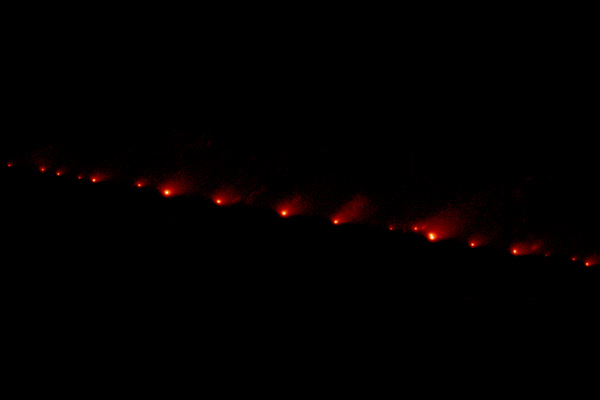 Shoemaker-Levy 9, imaged by Hubble telescope on May, 1994 / hubblesite.org
Shoemaker-Levy 9, imaged by Hubble telescope on May, 1994 / hubblesite.orgOne of the most famous comets, next to Halley's, Shoemaker-Levy 9 gave the world of astronomy a new window of information to view, but its effect on our world did not stop there. Its impact with the planet Jupiter brought to the forefront the dangers of impacts to the world and even spurred on apocalyptic genre movies such as "Armageddon" and "Deep Impact" in Hollywood.
Governmental agencies saw the devastation that comets and other large celestial objects could create thanks to this comet prompted funding for programs to watch for these NEO's (Near-Earth Objects) and to keep a close eye on them to make sure that we're ready if one were to head for us. Needless to say, this little comet may not have done anything more than get caught in Jupiter's gravitation web, but its little mishap created a lot of change and awareness for the entire world.
Discovery
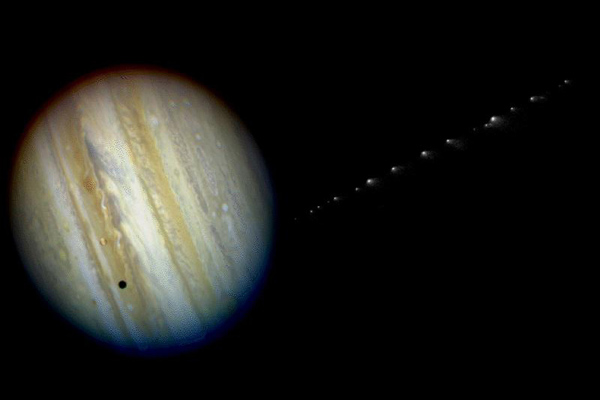 Illustration of Shoemaker-Levy 9 and Jupiter / hubblesite.org
Illustration of Shoemaker-Levy 9 and Jupiter / hubblesite.orgShoemaker-Levy 9 was the 9th comet discovered by astronomer couple Carol and Eugene Shoemaker and their colleague David Levy on March 24, 1993. The comet had gotten caught up in an orbit around Jupiter during its passing. It was the first comet found to orbit a planet and not the sun and is estimated to have done so for 20 to 30 years before its sighting.
Schmidt Telescope at the Palomar Observatory in California photographed this periodic comet, the images leading astronomers to believe that the comet was on approach to the sun when it got caught by Jupiter's pull in 1992. Jupiter's gravitational pull and its magnetic field being as powerful as it is, ripped the comet apart into smaller chunks. By 1993, Jupiter's pull brought it in where it crashed into its atmosphere and gave astronomers and awe-inspiring sight, allowing people to witness a large object impact and how Jupiter acts as a protection to Earth.
Orbit Around Jupiter
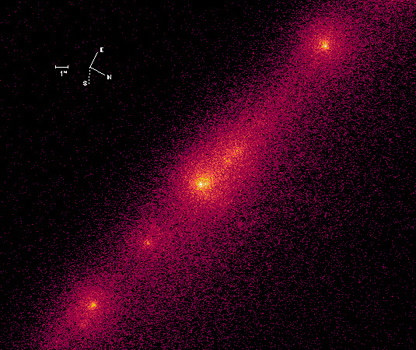 Shoemaker-Levy 9, imaged by Hubble telescope on July, 1993 / nasa.gov
Shoemaker-Levy 9, imaged by Hubble telescope on July, 1993 / nasa.govShoemaker-Levy 9 was orbiting around Jupiter at the time of its discovery. It had already been captured by Jupiter's pull since either the mid to late 60's to early 70's. As far as they can tell, Shoemaker-Levy 9 was a group of various smaller rocks that were held loosely by its own gravity and together the comet was only about 5 km (3.1 miles) in diameter.
Captured by Jupiter's gravity, Jupiter's strong gravitational forces pulled those rocks apart. That is when the Shoemakers and Levy discovered the comet orbiting Jupiter. It's orbit was at a distance roughly around 49 million km (30 million miles) in an eccentric orbit of 0.9986 which is very elliptic.
After discovery, the comet pieces to soon collide into Jupiter's atmosphere and this sent the astronomy society into a frenzy of excitement. Never before in human history has man-kind witnessed a large object impact into a planet. Preparations and anticipation began for the event so that they could view and record the event.
Impact
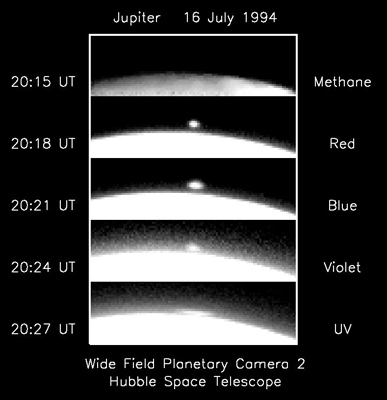 Impact fireball appears over the limb of Jupiter / hubblesite.org
Impact fireball appears over the limb of Jupiter / hubblesite.orgAs the predicted date grew near for the impact, several telescopes pointed towards Jupiter in hopes of documenting the event including the Hubble space telescope. Galileo spacecraft raced towards Jupiter to record the event as closely as it could along with the solar observer Ulysses spacecraft. Even Voyager 2, who was on its way out to the edge of our solar system, pointed towards Jupiter to watch the event.
Shoemaker-Levy 9 collided with Jupiter on July 16, 1994, sending fireballs out of the atmosphere on the back side of Jupiter. Only the three spacecraft recorded the impact but as Jupiter's orbit brought the impact zones into view, even low powered telescopes were able to see about 6,000 km (3,700 mi) in radius crescent-shaped dark spots left from the impact. These dark spots contained hydrogen sulfide and ammonia which surprised scientist.
Galileo recorded the impact and recorded a fireball that occurred from the impact. The recordings showed the temperature from the impact reached as high as 23,726°C (42,740°F) and the fireball reached a height of 3,000 km (1,864 miles) from the planet's cloud tops. Several years after the dark spots in the clouds disappeared, Galileo approach Jupiter to find that there was still a change in the clouds from the impact. Images detected ripples in the area of the impact and the entire ring tilted 2 km (1.24 miles).
After Impact Effects
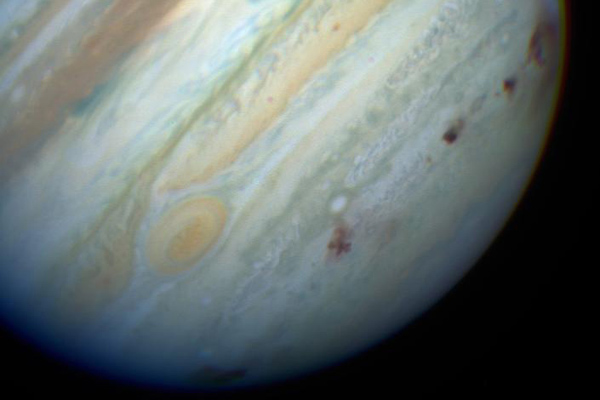 Brown spots mark impact sites on Jupiter's southern hemisphere / hubblesite.org
Brown spots mark impact sites on Jupiter's southern hemisphere / hubblesite.orgThis collision and its clear effect on a planetary system brought about much change. In 1998, the United States congress demanded that the National Aeronautics and Space Administration (NASA) support a program to find and track large objects 140 meters (459 feet) or larger that are near Earth. These objects are dangerous to the existence of life on our planet if they were to impact with Earth. So far, there are 19,500 such objects that fit this criterion and there is a constant vigilance kept on them.
Video Gallery

-
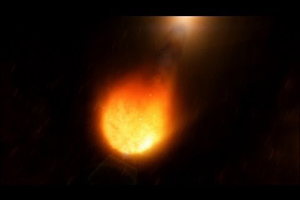 Comet Shoemaker Levy 9 - How The Universe Works
Comet Shoemaker Levy 9 - How The Universe Works
-
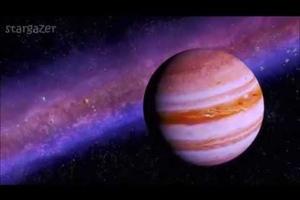 The Shoemaker-Levy 9 impacts
The Shoemaker-Levy 9 impacts
-
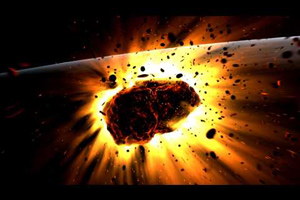 Visualization of Comet Shoemaker-Levy 9 Impact
Visualization of Comet Shoemaker-Levy 9 Impact